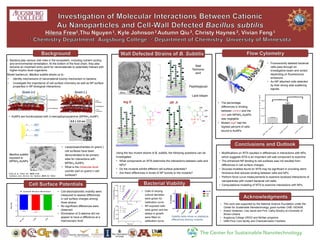
2016_ACS_Mutants-VF-HF
- 1. 1 1 2 2 2 1 • This work was supported by the National Science Foundation under the Center for Sustainable Nanotechnology, grant number CHE-1503408. • Ariane Vartanian, Lisa Jacob and Prof. Cathy Murphy at University of Illinois-Urbana • Augsburg College URGO and McNair programs • UMN Flow Core facility and Characterization Facilities • Bacteria play various vital roles in the ecosystem, including nutrient cycling and environmental remediation. At the bottom of the food chain, they also become an important entry point for nanomaterials to potentially interact with higher-trophic-level organisms. Model bacterium, Bacillus subtilis allows us to : • Identify mechanisms of nanomaterial toxicity mechanism to bacteria • Investigate the importance of cell surface chemistry as well as NP surface properties in NP-biological interactions. Gram (-)Gram (+) • AuNPs are functionalized with 3-mercaptopropylamine (MPNH2-AuNP). Wall Teichonic acid Peptidoglycan Lipid bilayer Using the two mutant strains of B. subtilis, the following questions can be investigated: • What components on WTA determine the interactions between cells and NPs? • Do the mutants exhibit different cell surface potentials? • Are there differences in levels of NP toxicity to the mutants? • Cell electrophoretic mobility were measured to assess differences in cell surface charges among three strains. • No significant differences were observed. • Elimination of D-alanine did not appear to have a difference at a macroscopic level. • Modifications on WTA resulted in differences in interactions with NPs, which suggests WTA is an important cell wall component to examine. • The enhanced NP-binding to cell surfaces was not resulted from differences in cell surface charges. • Glucose-moieties found on WTA may be significant in providing steric hindrance that reduces binding between cells and NPs. • Perform force curve measurements to examine localized interactions of nanoparticles with mutant bacterial cell walls. • Computational modeling of WTA to examine interactions with NPs. Bacillus subtilis exposed to MPNH2-AuNPs tag E S B 4 9 1 ta g E d ltA -4 -3 -2 -1 0 B . S u b tilis M u ta n t M o b ilitie s Mobility • Fluorescently labelled bacterial cells pass through an investigative beam and sorted depending on fluorescence emissions. • Au-NP attached cells detected by their strong side scattering signals • The percentage differences in binding between control and the dltA with MPNH2-AuNPs was negligible. • Mutant tagE had the highest percent of cells bound to AuNPs. 8.9 + 3.0 nm 1 µm1 µm S B 4 9 1 -5 p p m ta g E -5 p p m d ltA -5 p p m 0 2 0 4 0 6 0 %StainedCellswithAuNP * * * * * * dlt A 200 nm • Cells of varying cultural densities were grown for calibration curve. • NP-exposed cells were grown and the delays in growth were fitted on calibration curve. Viability tests show no statistical differences among mutants. • Lipopolysaccharides on gram(-) cell surfaces have been demonstrated to be primary sites for interactions with MPNH2-AuNPs. • What is the molecular-level counter part on gram(+) cell surfaces? Feng, et. al., Chem. Sci., 2015, 5186. Gunsolus, et al., Environ. Sci. Technol., 2015, 49, 10642.